Inspecting Your New Plantation
Each year, landowners establish thousands of acres of pine and hardwood plantations across the South. Unfortunately, some of these plantings end in failure. Young pine plantations are considered failures for sawtimber production once survival drops below 300–350 trees per acre (TPA). Hardwood plantations are usually planted at lower densities than those of pine, so hardwood plantations are considered a failure when survival drops below 230 TPA. However, unlike pine plantation silviculture, it is acceptable, and often beneficial, if other species of hardwoods are intermixed in a hardwood plantation. Working knowledge of individual hardwood species and how those species interact with planted species is required to correctly estimate the realistic tree density of most hardwood plantations. Often, volunteer seedlings (stems that arise from external seed sources) are beneficial in planted hardwood mixtures and should be counted toward overall success of the planting.
Landowners often wonder, “How do I know that I have a sufficient number of good seedlings in my new plantation?” This publication will answer that question by providing a simple, easy-to-use sampling technique for evaluating new plantations. Landowners with potential planting failures are encouraged to contact a forester for help.
Many planting efforts fail because owners do not perform post-planting compliance inspections. Plantation evaluations can be extremely useful if you use vendors to plant seedlings. Contracts with vendors specify the number of seedlings to be planted per acre. In addition, most contracts list what constitutes improper planting, including U-, J-, and L-rooting of seedlings, as well as excessive root pruning and incorrectly sealed planting slits. Ideally, landowners or their agents (consulting forester or Mississippi Forestry Commission forester) should check planting density and quality during planting operations. At that point, you can spot errors quickly and correct them before large areas are improperly planted. Also, a quick evaluation lets vendors know they have a satisfied client. Remember, if you encounter any problems during the planting operation, consult the planting manager. Always work through the manager to comply with federal regulations regarding employee/employer relationships. If the planting crew has moved to another job, consult your planting contractor directly to correct planting problems.
Subsequent plantation evaluations in early summer can detect survival problems due to planting shock. This is also the perfect time to evaluate problems with vegetative competition. Seedlings with little competition are called “free-to-grow” and should not need additional help. However, if site preparation treatments were not applied or failed and you discover competition issues, seedlings could be growing under intense competition. Under these pressures, seedlings are likely to die during the first growing season. Once potential seedling losses are estimated, you can make a decision regarding herbicides. Fall evaluations are perfect for measuring actual losses and will help determine if the planting is a failure or if additional seedlings need to be planted.
Improper Planting Techniques
When evaluating the success of a new plantation, you can’t always blame failure on the planting vendor. The planting vendor is only responsible for planting quality. In the event that your plantation fails due to insufficient competition control, flooding, extreme drought, or some other unavoidable environmental factor, the planting vendor is not responsible for replanting costs. Landowners should be aware that there are several reasons tree seedlings die after planting.
Seedling mortality is often a result of improper planting techniques, although it can also result from low-quality seedlings, improper on-site handling, and environmental factors. Pine bare-root (exposed root system) seedlings should have a root system approximately 6–8 inches in length, with a minimum of five first-order lateral roots (Figure 1). In addition, excluding longleaf pine (typically planted as containerized seedlings), pine seedlings should exhibit a balanced root/shoot ratio of close to 2:1, have a stem height of 10–12 inches, and have a root collar diameter of at least 7/32 of an inch. Containerized seedlings can vary greatly in size depending on age at planting and container volume. High-quality hardwood seedlings are somewhat larger, with properly sized root systems ranging between 8 and 10 inches, root collar diameters of at least 3/8 of an inch, and an overall height between 18 and 24 inches.
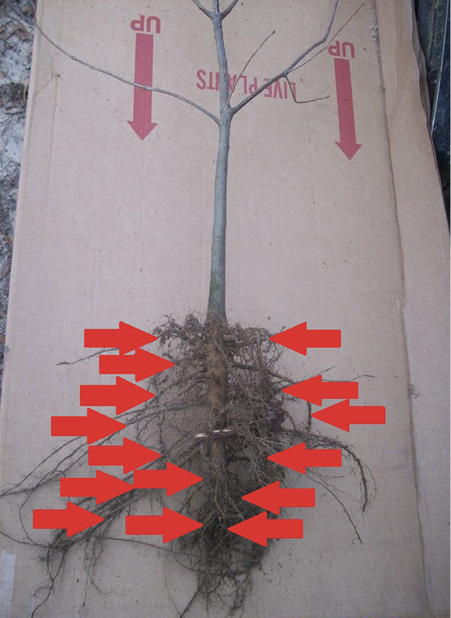
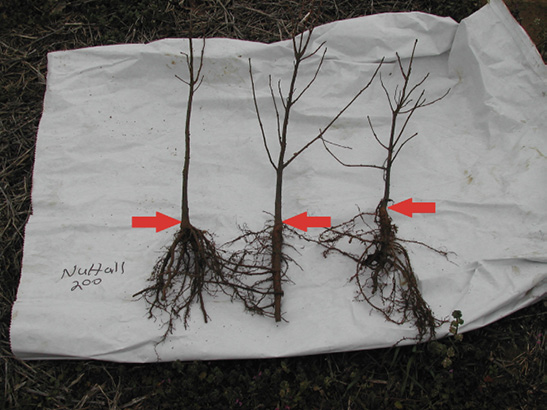
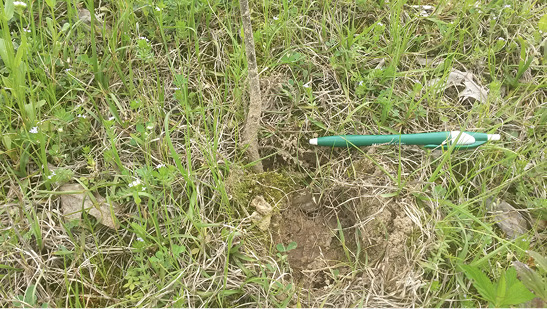
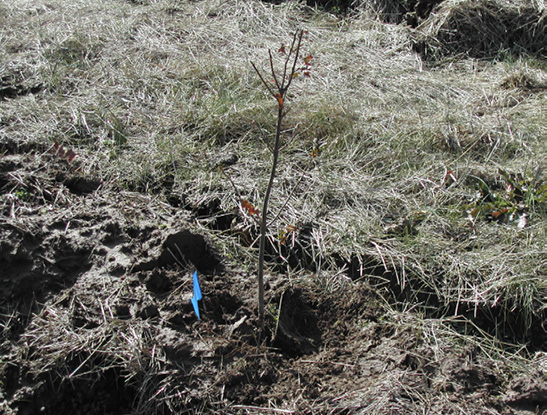
Seedlings should be planted at, or slightly deeper than, the root collar (Figure 2). Planting seedlings too shallow results in bent roots that are too close to the soil surface (Figure 3). Shallow-rooted seedlings have a much greater chance of dying during drought conditions or in plantings with high levels of herbaceous competition. Root systems should be well packed during planting operations to prevent root desiccation from air pockets (Figure 4). If machine planting, make sure not to drive the planting equipment too fast, which could result in seedlings being planted too shallow, exposed roots, and planting slits that do not receive the proper amount of soil packing.
Below are two examples of how shallow planting of bare-root seedlings can result in seedling mortality:
J- and U-rooting: J- and U-rooting of seedlings occurs when seedlings are planted in a hole or planting slit that is not deep enough to accommodate their root systems. Soil pressure forces the roots upward, forcing root systems to assume a J- or U-shape. These roots will not grow properly, and, the seedlings will eventually die (Figure 5).
L-rooting: In machine planting, typically a coulter or some other tool is used to cut a planting slit before seedlings are placed in the soil. While this reduces occurrence of U- and J-rooting, L-rooting can occur. L-rooting is the result of a planter moving too fast, with seedlings not being planted deeply enough. Root systems form an L-shape behind the seedling from being dragged forward slightly during the planting operation (Figure 5). Often, these seedlings will lean in the direction that the planting equipment moved. In addition, make sure the planter’s packing wheels are working properly. If wheels do not spin freely, they may slide along the soil surface during planting. Seedlings may then be pulled from the soil or broken off because of soil accumulation in front of the packing wheels.

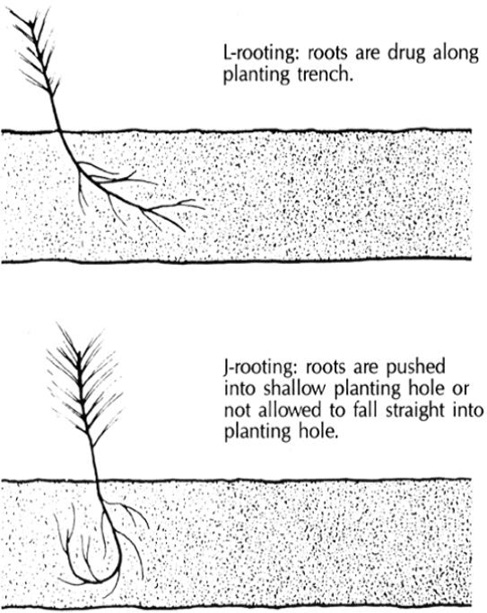
Excessive root pruning may also cause seedling mortality. Current nursery practices typically produce seedlings with a 6- to 8-inch root system. This means that root pruning, if necessary, has already occurred at the nursery and more pruning is not needed. If root systems consistently exceed the length of your planting tools, you should purchase new planting tools.
Ultimately, mishandling seedlings, using improper planting techniques, not planting at the necessary depth, or using seedlings with insufficient root systems will likely result in plantation failure. Seedlings die when incorrectly oriented roots do not develop properly and when roots desiccate because they are too close to the soil surface. For more information about proper planting techniques, see Mississippi State University Extension Publication 0160 Tree Planting Is Easy.
Plantation Measurements
While planting efforts are in process (or very soon afterward), you should randomly select several locations across the planting area to evaluate the quality of the planting job. First, are seedlings tight in the soil (checked using a firm upward tug), and are they planted at or slightly deeper than the root collar? If both of these conditions are met, you should then dig up a few seedlings to ensure proper root orientation. Careful excavation of planted seedlings will help you check for J-, U-, and L-rooting as well as loose- and shallow-planted seedlings.
The simplest method for determining TPA is to measure 1/100th-acre plots throughout the plantation. It is important to distribute these plots across the planting area to ensure an adequate sample. If plots are concentrated in one section of the planting, a non-representative TPA average might be calculated through disproportionate sampling of areas with higher or lower seedling survival. A 1/100th-acre plot has a radius of 11 feet, 9.3 inches. Use a center stake and a piece of string, twine, or rope cut to this length to establish the plot boundary. Establish a starting point to avoid double-counting seedlings, pick a direction in which to count, and count all seedlings within the plot boundary. Avoid moving back and forth within the plot while counting to avoid missing seedlings. Record data from each plot using Table 1 (see the PDF file at the top of this page), which includes form fields to help you with your calculations. Record the number of seedlings in free-to-grow status, those that are live but growing under weeds, and those that are dead. If a seedling is dead, it is important to extract it from the soil and determine the cause of death.
1. Determine stocking: count the number of trees in 1/100-acre plot (11 ft, 9.3 in radius)
2. Planting quality: evaluate seedlings near plot center (also all dead seedlings)
Calculations:
Total seedlings per acre = [(A + B + C) / # of plots measured] × 100 = ______ seedlings/acre
Live seedlings per acre = [(A + B) / # of plots measured] × 100 = ______ live seedlings/acre
Free-to-grow seedlings per acre = (A / # of plots measured) × 100 = ______ free-to-grow/acre
Percent survival = [(A + B) / (A + B + C)] × 100 = ______ % survival
Percent of plots failing quality test = (D / # of plots measured) × 100 = ______ % plots failing test
Evaluating the Data
Trees per Acre
Targeted plantation density is a decision made based on management objectives. The average suggested pine plantation density has decreased over the past couple of decades due to improved available genetic materials, better silvicultural methods, and decreased demand for pulpwood. While stocking levels as high as 1,000 TPA were recommended in the past, the current suggested stocking levels are between 450 and 600 TPA. Recommended hardwood seedling densities are typically lower than those of pine. Historically, most hardwood plantations (especially those enrolled in cost-share incentive programs) were planted using a density of 302 TPA (12 feet by 12 feet), but recent allowances in these cost-sharing programs have increased permissible planting density to 435 TPA (10 feet by 10 feet).
Seedling spacing for a number of different plantation densities is given in Table 2. These spacing options can be used to formulate a reasonable expectation for seedling numbers and locations within your measurement plots. If the average seedling count is low, more seedlings need to be planted. Pine plots should have at least three live seedlings each (300 TPA), and hardwood plots should have at least two live seedlings each (200 TPA). If the planting is new, plant additional seedlings in low-count areas. If only a low number of residual trees have survived in the planting and have reached a size that will limit survival and growth of replanted seedlings, other contingencies, such as replanting the entire population, may be necessary.
New Plantings
If the plantation is deemed a failure, then replant. If 1-month survival is below 80 percent and seedlings were planted properly, it is likely that they were poorly stored or handled during transportation to or upon arrival at the planting site. Replanting by the vendor may be required. Once the planting job passes inspection, pay the vendor.
|
Spacing (ft) |
TPA |
|
5 x 10 |
871 |
|
6 x 6 |
1210 |
|
6 x 8 |
908 |
|
6 x 9 |
807 |
|
6 x 10 |
726 |
|
6 x 12 |
605 |
|
7 x 7 |
889 |
|
7 x 8 |
778 |
|
7 x 9 |
691 |
|
7 x 10 |
622 |
|
7 x 12 |
519 |
|
8 x 8 |
681 |
|
8 x 9 |
605 |
|
8 x 10 |
544 |
|
9 x 9 |
538 |
|
9 x 10 |
484 |
|
10 x 10 |
435 |
|
10 x 12 |
363 |
First Growing Season
By late spring and at the end of the first growing season, the number of live free-to-grow seedlings should be well over 300 TPA for pines and 230 TPA for hardwoods. If herbaceous competition is severe, a release treatment may be necessary to ensure future seedling survival. If the number of free-to-grow seedlings drops below these levels, landowners have three options:
Do nothing: If your original planting was comprised of pines, accept that you will not have a “pine” plantation in the future. Volunteer hardwood stems will encroach and become an increasingly important component in the stand. While traditionally considered a highly undesirable option, some landowners are starting to explore mixed hardwood-pine management because the pine market in Mississippi has been reduced over the past decade and a half. The mix may offer a diversified product offering at maturity.
If hardwoods were the original planting, many of the same volunteer species are likely to establish as they would in the pine stands described above. This scenario is not entirely undesirable. Depending on the residual density of planted seedlings, as well as that of volunteer stems, overall stand development may improve compared to a pure stand of one hardwood species. Consult a forester to evaluate future potential of the stand.
Rehabilitate plantation: If rehabilitation is to occur within the first year after the initial planting, plant additional seedlings (Figure 6). Use herbaceous weed control if it will control the vegetation present.
Start over: Apply site-preparation herbicides and replant. This may be the best option when existing non-tree vegetation cannot be controlled with herbaceous weed control as mentioned in option 2. It is also the correct option in scenarios where residual seedling numbers are extremely low and the initial plantation is deemed unsalvageable.
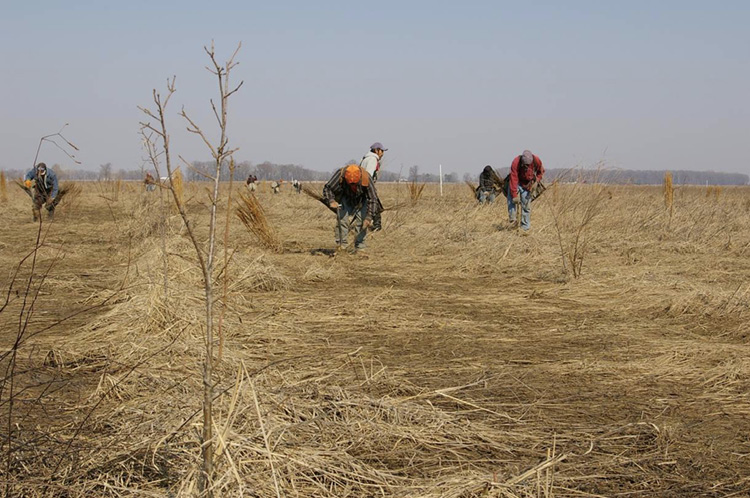
Conclusion
Thousands of acres of plantations are established throughout Mississippi each year. Many of these plantations fail because of improper planting. The procedures listed in this publication will help you determine the condition of your plantation. Evaluate the plantation as soon as possible after planting so that you can take corrective action if necessary. If you suspect that you have a plantation failure, contact your consulting forester, a Mississippi Forestry Commission forester, or your local MSU Extension office.
Additional Reading
Kushla, J., and Ezell, A. W. 2017. Tree planting is easy. Mississippi State University Extension Publication 0160.
Publication 3143 (POD-01-24)
By A. Brady Self, PhD, Associate Extension Professor, and Stephen Dicke, PhD, Professor Emeritus, Forestry.
The Mississippi State University Extension Service is working to ensure all web content is accessible to all users. If you need assistance accessing any of our content, please email the webteam or call 662-325-2262.




